Abstract
Encephalomyocarditis virus in aerosols is inactivated rapidly at relative humidities below 50%. In glycerol-water mixtures a similar decrease of infectivity occurs when the glycerol concentration exceeds 78% (wt/wt), corresponding to a relative humidity of 50%. The decay in aerosols does not involve oxygen or surface-dependent factors. Variation of temperature shows the inactivation to be a low-energy process with an activation enthalpy of 15 kcal per mol. The damage could be ascribed to dehydration of the virion, presumably proceeding to removal of structurally essential water molecules. This might trigger irreversible changes in the protein coat, resulting in disintegration of the virion.
Full text
PDF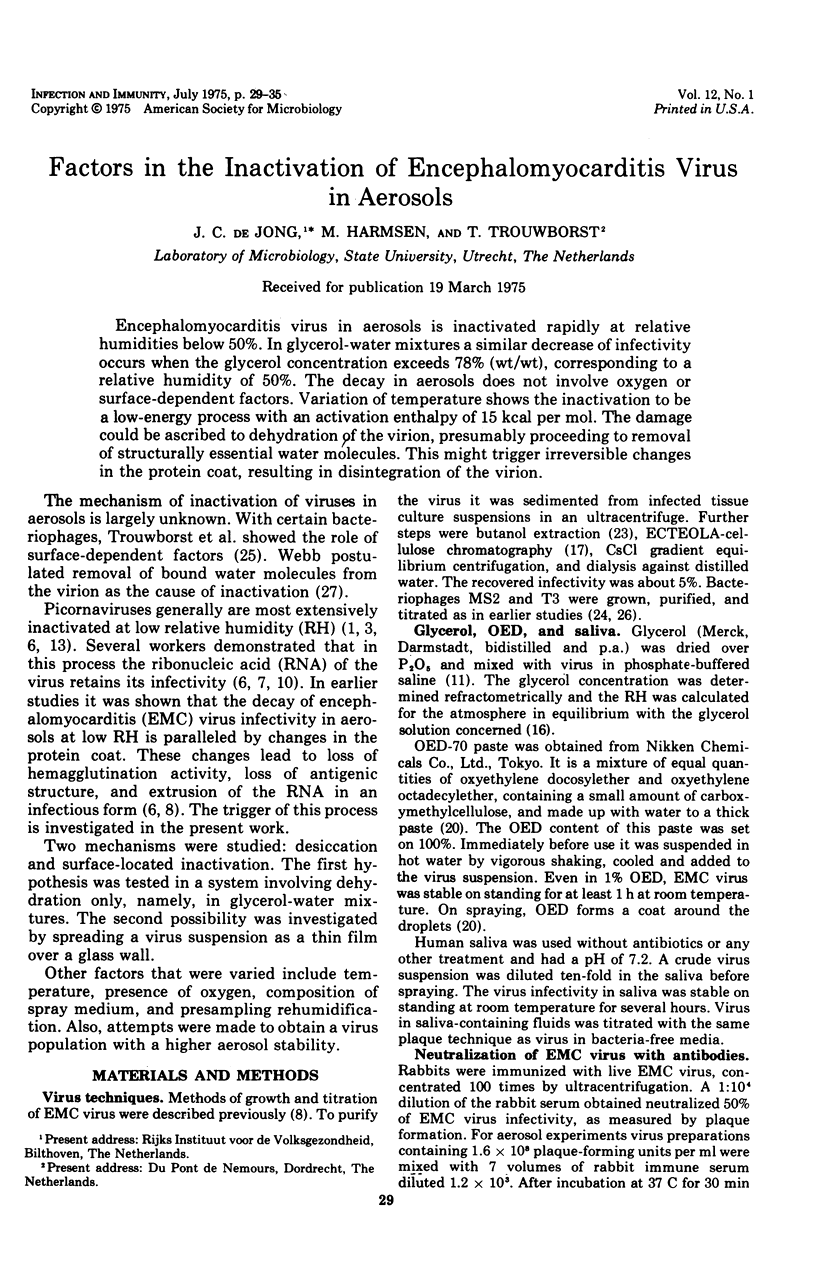
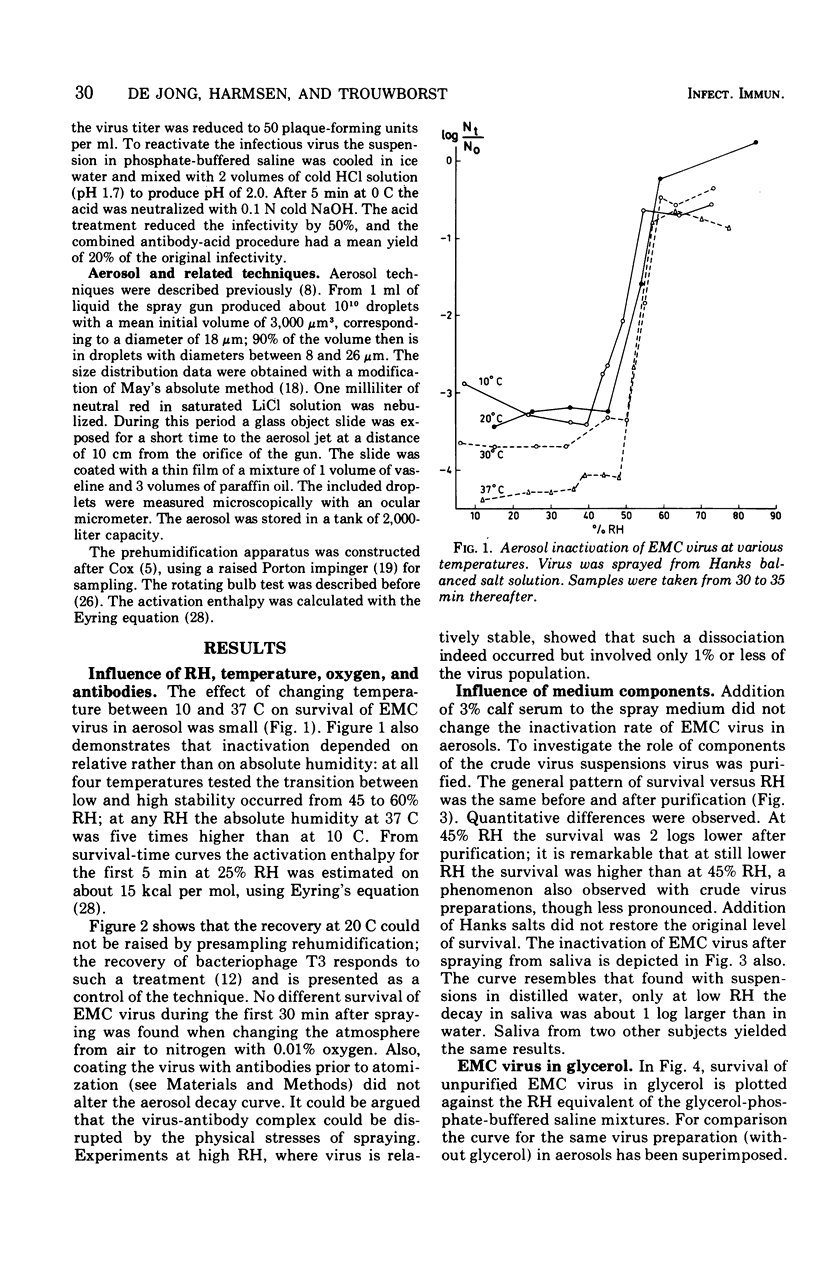
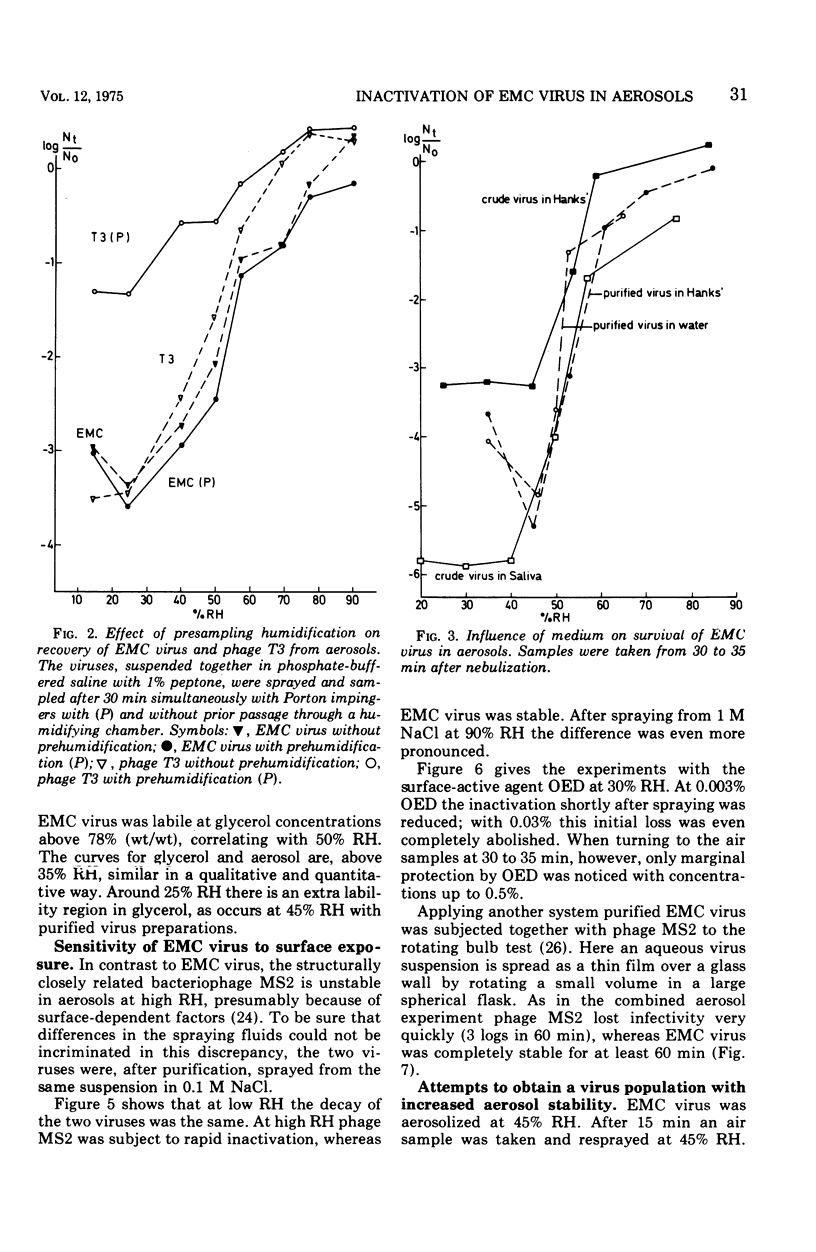
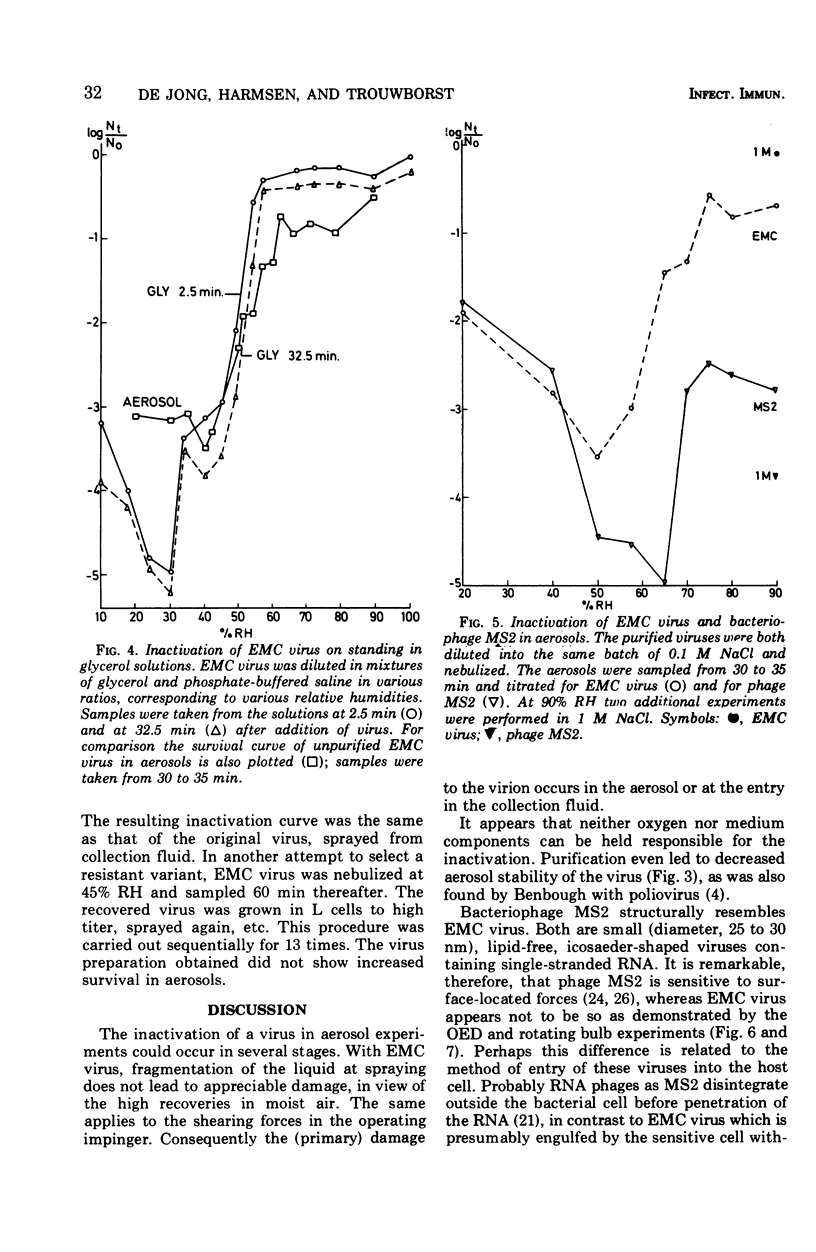
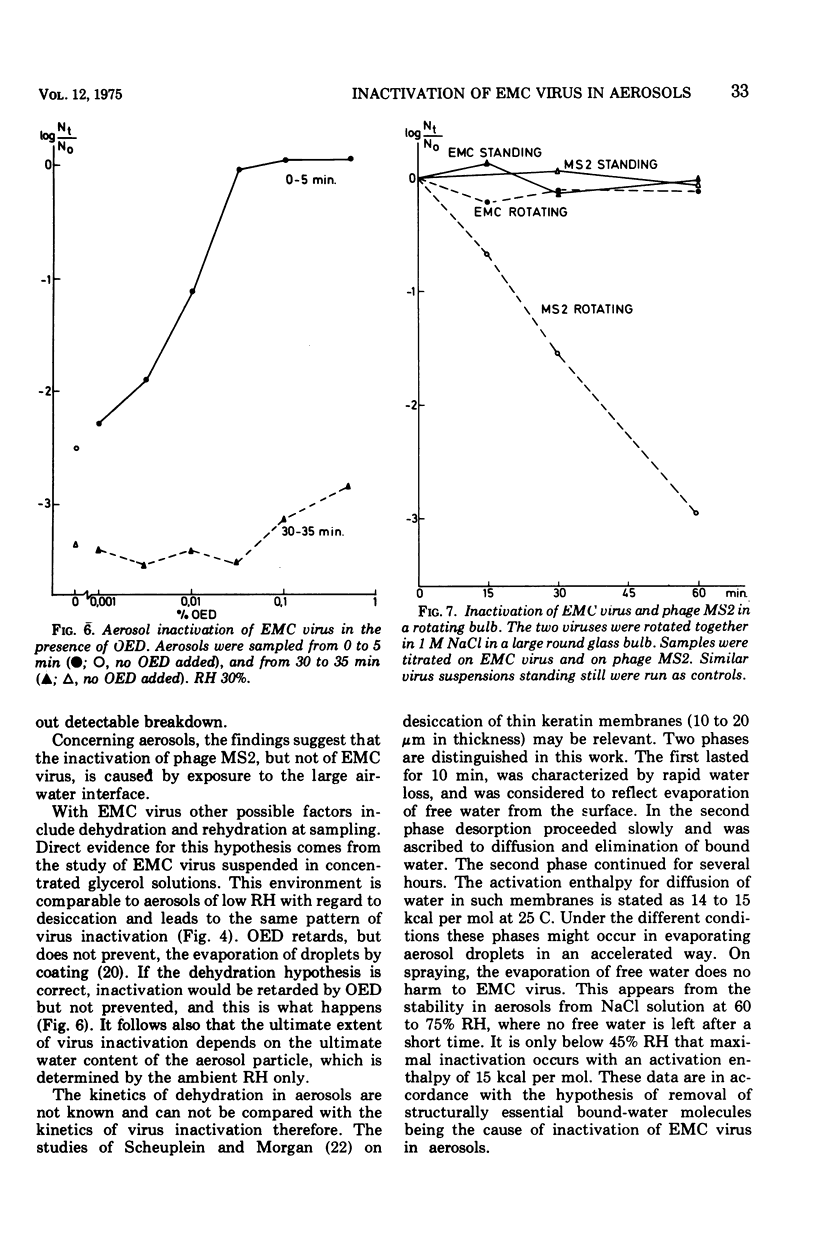
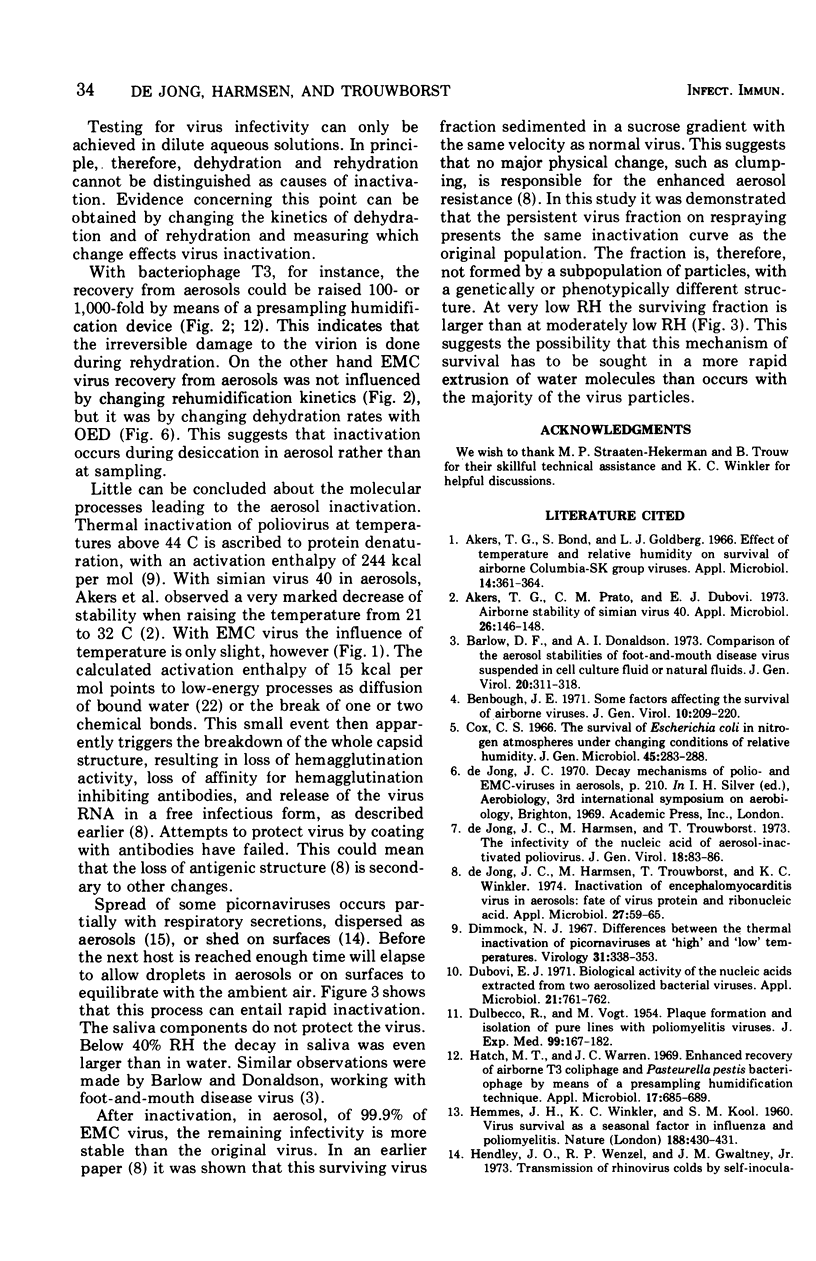
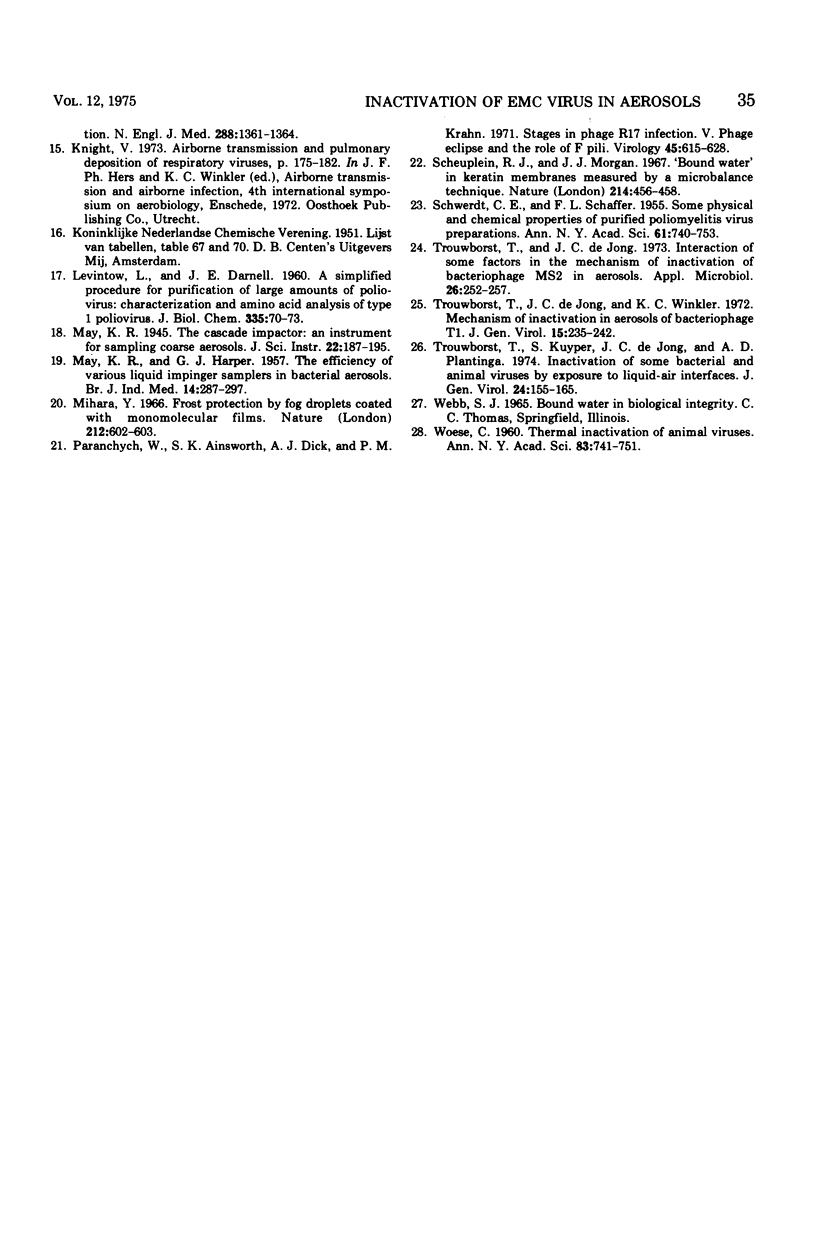
Selected References
These references are in PubMed. This may not be the complete list of references from this article.
- Akers T. G., Bond S., Goldberg L. J. Effect of temperature and relative humidity on survival of airborne Columbia SK group viruses. Appl Microbiol. 1966 May;14(3):361–364. doi: 10.1128/am.14.3.361-364.1966. [DOI] [PMC free article] [PubMed] [Google Scholar]
- Akers T. G., Prato C. M., Dubovi E. J. Airborne stability of simian virus 40. Appl Microbiol. 1973 Aug;26(2):146–148. doi: 10.1128/am.26.2.146-148.1973. [DOI] [PMC free article] [PubMed] [Google Scholar]
- Barlow D. F., Donaldson A. I. Comparison of the aerosol stabilities of foot-and-mouth disease virus suspended in cell culture fluid or natural fluids. J Gen Virol. 1973 Sep;20(3):311–318. doi: 10.1099/0022-1317-20-3-311. [DOI] [PubMed] [Google Scholar]
- Benbough J. E. Some factors affecting the survival of airborne viruses. J Gen Virol. 1971 Mar;10(3):209–220. doi: 10.1099/0022-1317-10-3-209. [DOI] [PubMed] [Google Scholar]
- Cox C. S. The survival of Escherichia coli in nitrogen atmospheres under changing conditions of relative humidity. J Gen Microbiol. 1966 Nov;45(2):283–288. doi: 10.1099/00221287-45-2-283. [DOI] [PubMed] [Google Scholar]
- DULBECCO R., VOGT M. Plaque formation and isolation of pure lines with poliomyelitis viruses. J Exp Med. 1954 Feb;99(2):167–182. doi: 10.1084/jem.99.2.167. [DOI] [PMC free article] [PubMed] [Google Scholar]
- De Jong J. C., Harmsen M., Trouwborst T. The infectivity of the nucleic acid of aerosol-inactivated poliovirus. J Gen Virol. 1973 Jan;18(1):83–86. doi: 10.1099/0022-1317-18-1-83. [DOI] [PubMed] [Google Scholar]
- Dimmock N. J. Differences between the thermal inactivation of picornaviruses at "high" and "low" temperatures. Virology. 1967 Feb;31(2):338–353. doi: 10.1016/0042-6822(67)90179-1. [DOI] [PubMed] [Google Scholar]
- Dubovi E. J. Biological activity of the nucleic acids extracted from two aerosolized bacterial viruses. Appl Microbiol. 1971 Apr;21(4):761–762. doi: 10.1128/am.21.4.761-762.1971. [DOI] [PMC free article] [PubMed] [Google Scholar]
- HEMMES J. H., WINKLER K. C., KOOL S. M. Virus survival as a seasonal factor in influenza and polimyelitis. Nature. 1960 Oct 29;188:430–431. doi: 10.1038/188430a0. [DOI] [PubMed] [Google Scholar]
- Hatch M. T., Warren J. C. Enhanced recovery of airborne T3 coliphage and Pasteurella pestis bacteriophage by means of a presampling humidification technique. Appl Microbiol. 1969 May;17(5):685–689. doi: 10.1128/am.17.5.685-689.1969. [DOI] [PMC free article] [PubMed] [Google Scholar]
- Hendley J. O., Wenzel R. P., Gwaltney J. M., Jr Transmission of rhinovirus colds by self-inoculation. N Engl J Med. 1973 Jun 28;288(26):1361–1364. doi: 10.1056/NEJM197306282882601. [DOI] [PubMed] [Google Scholar]
- LEVINTOW L., DARNELL J. E., Jr A simplified procedure for purification of large amounts of poliovirus: characterization and amino acid analysis of Type 1 poliovirus. J Biol Chem. 1960 Jan;235:70–73. [PubMed] [Google Scholar]
- MAY K. R., HARPER G. J. The efficiency of various liquid impinger samplers in bacterial aerosols. Br J Ind Med. 1957 Oct;14(4):287–297. doi: 10.1136/oem.14.4.287. [DOI] [PMC free article] [PubMed] [Google Scholar]
- Paranchych W., Ainsworth S. K., Dick A. J., Krahn P. M. Stages in phage R17 infection. V. Phage eclipse and the role of F pili. Virology. 1971 Sep;45(3):615–628. doi: 10.1016/0042-6822(71)90176-0. [DOI] [PubMed] [Google Scholar]
- SCHWERDT C. E., SCHAFFER F. L. Some physical and chemical properties of purified poliomyelitis virus preparations. Ann N Y Acad Sci. 1955 Sep 27;61(4):740-50; discussion, 750-3. doi: 10.1111/j.1749-6632.1955.tb42530.x. [DOI] [PubMed] [Google Scholar]
- Scheuplein R. J., Morgan L. J. "Bound water" in keratin membranes measured by a microbalance technique. Nature. 1967 Apr 29;214(5087):456–458. doi: 10.1038/214456a0. [DOI] [PubMed] [Google Scholar]
- Trouwborst T., Kuyper S., de Jong J. C., Plantinga A. D. Inactivation of some bacterial and animal viruses by exposure to liquid-air interfaces. J Gen Virol. 1974 Jul;24(1):155–165. doi: 10.1099/0022-1317-24-1-155. [DOI] [PubMed] [Google Scholar]
- Trouwborst T., de Jong J. C. Interaction of some factors in the mechanism of inactivation of bacteriophage MS2 in aerosols. Appl Microbiol. 1973 Sep;26(3):252–257. doi: 10.1128/am.26.3.252-257.1973. [DOI] [PMC free article] [PubMed] [Google Scholar]
- Trouwborst T., de Jong J. C., Winkler K. C. Mechanism of inactivation in aerosols of bacteriophage T 1 . J Gen Virol. 1972 Jun;15(3):235–242. doi: 10.1099/0022-1317-15-3-235. [DOI] [PubMed] [Google Scholar]
- WOESE C. Thermal inactivation of animal viruses. Ann N Y Acad Sci. 1960 Jan 13;83:741–751. doi: 10.1111/j.1749-6632.1960.tb40943.x. [DOI] [PubMed] [Google Scholar]
- de Jong J. C., Harmsen M., Trouwborst T., Winkler K. C. Inactivation of encephalomyocarditis virus in aerosols: fate of virus protein and ribonucleic acid. Appl Microbiol. 1974 Jan;27(1):59–65. doi: 10.1128/am.27.1.59-65.1974. [DOI] [PMC free article] [PubMed] [Google Scholar]


